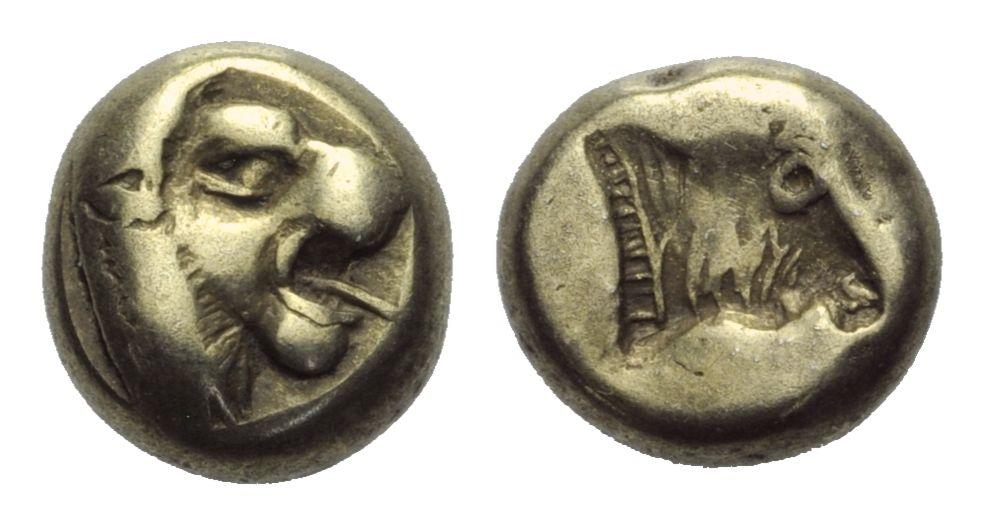AC 212 - Mytilene, electrum, hekte, 477-455 BC
From SILVER
477 BCE - 455 BCE Electrum 11,655 kg
Description
| ObverseInscription or printing placed on the obverse.: | Head of a lion with opened mouth on the right. |
| ReverseInscription or printing placed on the reverse.: | Incuser head of calf right. |
Mint and issuing power
| MintIdentifies the place of manufacture or issue of a numismatic object.: | Mytilene | Ancient regionAncient region.: | Aeolis (islands) | Modern countryModern country: Greece | AuthorityIdentifies the issuing power. The authority can be "pretended" when the name or the portrait of X is on the coin but he/she was not the issuing power. It can also be "uncertain" when there is no mention of X on the coin but he/she was the issuing power according to the historical sources: |
Chronology
| FromIdentifies the initial date in a range assigned in a numismatic context. | 477 BCE | toIdentifies the final date in a range assigned in a numismatic context.. | 455 BCE | PeriodTime period of the numismatic object.: Classical 480-323 BC |
Physical description
| MetalThe physical material (usually metal) from which an object is made.: | Electrum http://nomisma.org/id/el | Median weightMedian of the weights of numismatic objects (in grams). in grams | 2.50 | DenominationTerm indicating the value of a numismatic object. Examples: tetradrachm, chalkous, denarius.: | hekte |
StandardStandard.: |
Image

AC212 Mytilene.jpeg [1]
References
Obverse dies distribution
| FrequencyFrequency of specimen in distribution. ᵖ | Number of obversesNumber of obverse dies. ᵖ (o) | % (o) | Number of coinsNumber of coins. (n) | % (n) | Die nameName(s) of the die(s). |
| 1 | 5 | 27.78 | 5 | 9.62 | 24a, 26a, 31a, 32a, 34a |
| 2 | 5 | 27.78 | 10 | 19.23 | 23b, 25a, 27b, 29b, 29c |
| 3 | 2 | 11.11 | 6 | 11.54 | 24b, 27c |
| 4 | 2 | 11.11 | 8 | 15.38 | 24c, 28a |
| 5 | 1 | 5.56 | 5 | 9.62 | 29a |
| 6 | 3 | 16.67 | 18 | 34.62 | 23a, 27a, 30a |
| Total | 18 of 18 | 100.01 | 52 of 52 | 100.01 |
Reverse dies distribution
no distribution is available
Quantification
| Number of obversesNumber of obverse dies. ᵖ (o) | 18 | Number of singletons (o1)The number of singleton coins. ᵖ | 5 |
| Number of reverse diesNumber of reverse dies. (r) | NC"NC" is not a number. | Number of coinsNumber of coins. (n) | 52 |
| Coins per obverse dieNumber of coins per obverse die. (n/o) | 2.89 | Coins per reverse dieNumber of coins per reverse die. (n/r) | |
| Reverse per obverse ratioRatio of obverse dies divided by reverse dies. (r/o) | Percentage of singletons (o1)number of coins (n) divided by the number of singletons (o1) ᵖ | 27.78 % | |
| Original number of dies (O) (Carter 1983 formula)The estimation of the number of coins according to Carter 1983 ᵖ | 23.31 | Coins struck if 20,000 as average productivity per dieCoins made if the average productivity for obverses (according to Carter) is 20,000. ᵖ | 466,200 |
| Original number of dies (O) (Esty 2011 formula)The estimation of the number of coins according to the singleton formula in Esty 2011 ᵖ (O) | 27.53 | Survival rate if 20,000 as average productivity per dieSurvival rate if average productivity is 20,000. ᵖ | 0.00011 |
| Coverage (o = % of O) (Esty 1984 formula)Esty 1984 - coverage (% of O) ᵖ (o = % of O) | 90.38% | Die productivity if survival rate 1/2,000Average productivity if survival rate is 1/2,000. ᵖ | 4,461.6 |
| Weight of silver (in kg) if 20,000 coins per die (O = Carter formula)Carter 1983 * Median weight * 20000 (*10 if gold or electrum) ᵖ | 11,655 kg <br /> 11,655 kg | Die productivity if survival rate 1/5,000Average productivity if survival rate is 1/5,000. ᵖ | 11,154.01 |
Remarks